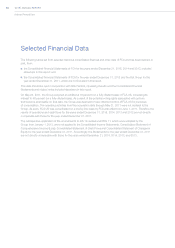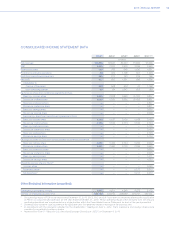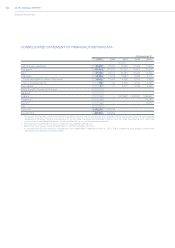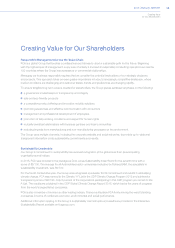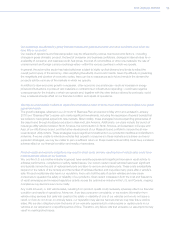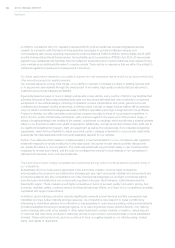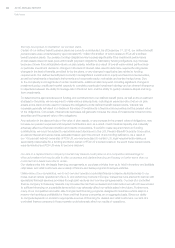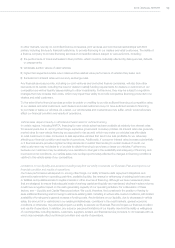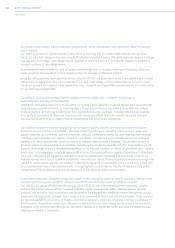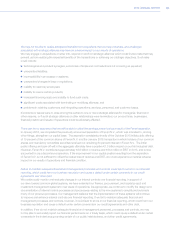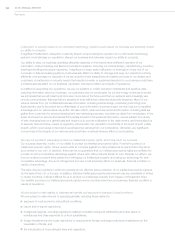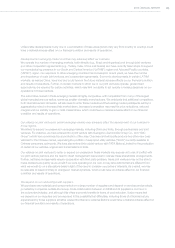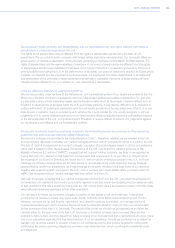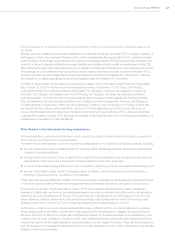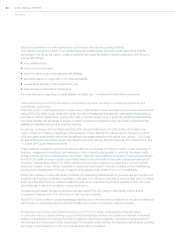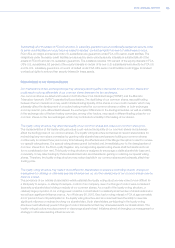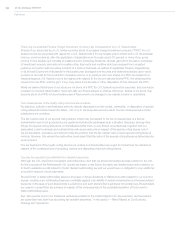Chrysler 2015 Annual Report Download - page 20
Download and view the complete annual report
Please find page 20 of the 2015 Chrysler annual report below. You can navigate through the pages in the report by either clicking on the pages listed below, or by using the keyword search tool below to find specific information within the annual report.
20 2015 | ANNUAL REPORT
Risk Factors
Our current credit rating is below investment grade and any further deterioration may significantly affect our funding
and prospects.
Our ability to access the capital markets or other forms of financing and the related costs depend, among other
things, on our credit ratings and we are currently rated below investment grade. The rating agencies review our ratings
regularly and, accordingly, new ratings may be assigned to us in the future. It is not currently possible to predict the
timing or outcome of any ratings review.
Any downgrade may increase our cost of capital and potentially limit our access to sources of financing, which may
cause a material adverse effect on our business prospects, earnings and financial position.
Since the rating agencies may separately review and rate FCA US on a stand-alone basis, it is possible that our credit
ratings may not benefit from any improvements in FCA US’s credit ratings or that a deterioration in FCA US’s credit
ratings could result in a negative rating review of us. See —Liquidity and Capital Resources below for more information
on our financing arrangements.
Our ability to achieve cost reductions and to realize production efficiencies is critical to maintaining our
competitiveness and long-term profitability.
While some productivity improvements are within our control, others depend on external factors, such as commodity
prices, supply capacity limitations, or trade regulation. These external factors may make it more difficult to reduce
costs as planned, and we may sustain larger than expected production expenses, materially affecting our business
and results of operations. Furthermore, reducing costs may prove difficult due to the need to introduce new and
improved products in order to meet consumer expectations and government regulations.
Our business operations may be impacted by various types of claims, lawsuits, and other contingent obligations.
We are involved in various product liability, warranty, product performance, asbestos, personal injury, dealer and
supplier disputes, environmental claims and lawsuits, antitrust, intellectual property, tax and other legal proceedings
including those that arise in the ordinary course of our business. We estimate such potential claims and contingent
liabilities and, where appropriate, record provisions to address these contingent liabilities. The ultimate outcome of
the legal matters pending against us is uncertain, and although such claims, lawsuits and other legal matters are not
expected individually to have a material adverse effect on our financial condition or results of operations, such matters
could have, in the aggregate, a material adverse effect on our financial condition or results of operations. Furthermore,
we could, in the future, be subject to judgments or enter into settlements of lawsuits and claims that could have a
material adverse effect on our results of operations in any particular period. While we maintain insurance coverage with
respect to certain claims, we may not be able to obtain such insurance on acceptable terms in the future, if at all, and
any such insurance may not provide adequate coverage against any such claims. See also Notes 22 and 28 of the
Consolidated Financial Statements included elsewhere in this report for additional information.
A significant malfunction, disruption or security breach compromising the electronic control systems contained in our
vehicles could damage our reputation, disrupt our business and adversely impact our ability to compete.
Our vehicles, as well as vehicles manufactured by other OEMs, contain interconnected and increasingly complex
systems that control various vehicle processes including engine, transmission, safety, steering, brakes, window
and door lock functions. Such internal and vehicle systems are susceptible to malfunctions and interruptions due to
equipment damage, power outages, and a range of other hardware, software and network problems. These systems
are also susceptible to cybercrime, or threats of intentional disruption, which are increasing in terms of sophistication
and frequency. A significant malfunction, disruption or security breach compromising the electronic control systems
contained in our vehicles could damage our reputation, expose us to significant liability and have a material adverse
effect on our results of operations.


